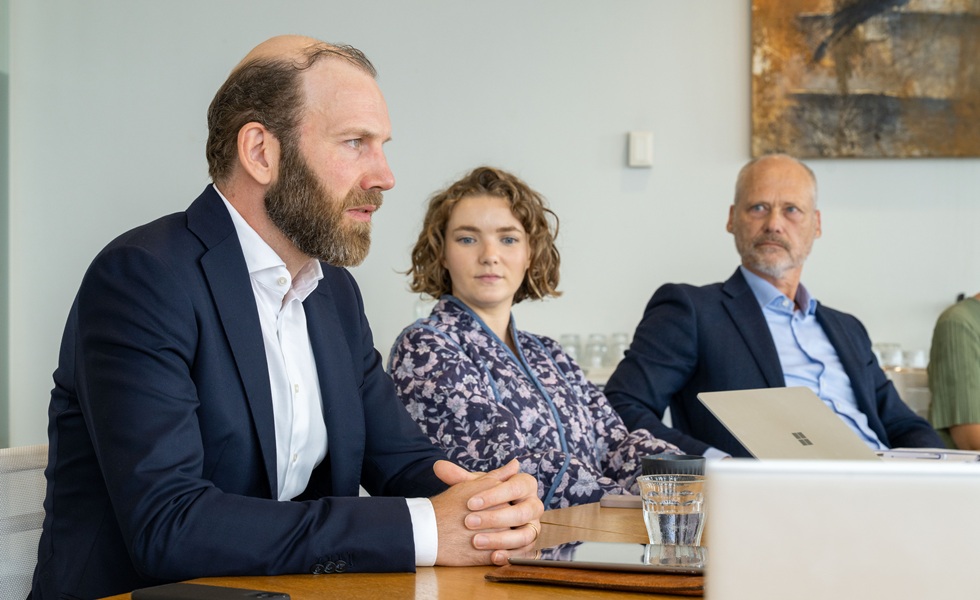Measurable impact and scaling up of biodiversity investments (Roundtable 'Biodiversity' – part 3)
Measurable impact and scaling up of biodiversity investments (Roundtable 'Biodiversity' – part 3)

This text was originally written in Dutch. This is an English translation.
In this third part of the roundtable report, we discuss how biodiversity investments can be made measurable and scalable. Experts share insights on protection, restoration and sustainable strategies, with a focus on emerging markets, financial instruments and the importance of collaboration between investors, science and local communities.
By Hans Amesz
This is part 3 of the report. You can read part 1 here, and part 2 here.
|
MODERATOR Don Gerritsen, Deloitte
PARTICIPANTS Jolien de Jongh, Achmea Real Estate Sophie Kamphuis, MN Sasha Miller, Nuveen Lucian Peppelenbos, Robeco Robert- Alexandre Poujade, BNP Paribas Asset Management Gerard Roelofs, Impact Orange Partners Nikki Trip, AF Advisors |
When making biodiversity-focused investments, do you distinguish between projects aimed at “protection”, “maintenance” or “restoration” of nature?
Roelofs: 'Right now, mainly protection, restoration in the short term and ultimately everything at once. We often talk about land and air, but too little about the sea: fishing, oceans, water pollution, plastics. The destruction is happening at an alarming rate. Let's first stop what is going wrong. The maritime treaties exist, but enforcement in “free” areas is lacking. We must use public and pension capital to halt the loss of biodiversity.'
Miller: 'We distinguish between protection and restoration. To build on this, we also invest in the maritime sector with clear KPIs, for example through blue bonds. Our experience shows that success requires an approach involving multiple stakeholders, such as the fishing industry, governments and NGOs, and that putting it into practice can also take time.'
De Jongh: 'To get things done, it can also help to set a good example. Just do it, start small, make it visible and share it with lots of people. What also helps is explaining biodiversity in recognisable terms. It's nature, it's swimming in the sea, it's healthy air. Nobody is against that. Share it with the media too, for example the local newspaper and via LinkedIn. Setting a good example encourages others to follow suit.'
Poujade: 'Consider the health aspect as well. Health is a powerful lever. In France, there has been a lot of fuss about the mercury content in tuna. Some French cities now prohibit the consumption of tuna in school canteens. Awareness of health can increase awareness of biodiversity protection.'
Trip: 'Unfortunately, 'health' has rarely deterred or motivated companies, even when human lives are at stake. PFAS and microplastics are everywhere: fish from the Westerschelde, for example, are no longer safe for consumption. I hope that health reasons will motivate people to do something, but as long as this is not financially valued or otherwise standardised, I have little hope.'
Poujade: 'Then it has to come from consumers and stakeholders and be reflected in companies. Local investment also helps; people recognise ecosystems and feel a sense of ownership.'
How do you make nature measurable at the level of the issuer or security, i.e. relevant to investment decisions?
Peppelenbos: 'We look at the exposure, performance and mitigation of issuers. The raw data changes from one year to the next. But if you rank companies by efficiency, if you look at the trends of each company over three years, you start to see patterns and the data becomes more stable. Datasets are improving rapidly; we enrich them with AI. This gives you a good indication of the frontrunners and laggards, which you can use when putting together a portfolio.'
Kamphuis: 'In making nature measurable, we distinguish five drivers of biodiversity loss and try to map the impact of the issuer for each of these drivers, insofar as it is material to the company. Although data quality and availability have improved enormously in recent years, we see that for some impact drivers, such as pollution, the quality of the data still lags behind and there is still no agreement on transition paths. This is certainly no excuse for not taking action. For other drivers, such as land and water use, sufficient information is available to identify frontrunners and laggards, and setting portfolio targets can be explored. Transparency among data providers and the lack of value chain information remains an issue, and for biodiversity we prefer to use as much raw data as possible and less overarching ESG scores.'
Miller: 'Good measurement is expensive. We distinguish between sustainable timber/farmland strategies and Nature-based Solutions impact strategies. In both cases, measurement is part of how we invest.'
Poujade: 'In our forestry assets, we are cautious in claiming positive impact: the baseline and lead time are crucial, as is soil in agriculture. We reserve budget for mitigation and protection in the investment model, but asset owners sometimes have to accept that the IRR could be slightly lower if you want to measure real impact.'
Kamphuis: 'We are also interested in forestry investments that focus on partial or complete restoration of forest ecosystems, which means that the claim of positive impact can be better substantiated than with regular forestry investments. Ideally, you want to align impact monitoring as closely as possible with current scientific methods. This is costly and time-consuming, but necessary. Are we, as investors, willing to pay for this?'
Trip: 'Biodiversity conservation or restoration does not always have to yield a financial return. Where it does, it is a suitable investment for institutional investors. If not, the government should play a role in this.'
Peppelenbos: 'To give an example: a private debt fund provides loans to agricultural companies in biodiversity-rich areas at risk of deforestation. The loan includes KPIs for forest conservation or restoration at favourable, long maturities and with strict defaults on environmental KPIs. This works, and the portfolio is performing well.'
Miller: 'Restoration also leads to carbon removal credits, but it can take longer to access them than if you had immediate access to avoidance credits. The IRR dynamics can change. We can achieve a similar result in public markets, such as the Amazon reforestation bond, where the payoff is directly linked to removal credits, and we have also added biodiversity KPIs.'
Biodiversity hotspots are often located in emerging markets. Should institutional investors be more willing to invest in those markets?
Kamphuis: 'Many biodiversity hotspots are indeed located in emerging markets, and we are certainly seeing more interest from pension funds in investigating these markets for their impact potential. Ultimately, this does require a significant adjustment to current products and mandates. People need to be prepared to do that. However, this could mean that it comes at the expense of the risk budget of another product and the associated impact. I am in favour of jointly exploring innovative instruments and looking at which factors in the design can provide sufficient comfort for institutional investors. That said, there is also an urgent need to restore biodiversity in developed markets.'
Our experience shows that success requires an approach involving multiple stakeholders, and that putting it into practice can also take time and money
Miller: 'It’s an important issue. Many people say they want to have an impact in emerging markets, but many investors do not allocate capital there. Of course, there are currency risks and other factors that influence the ability of institutional investors to invest capital in emerging markets. That is precisely where capital is most needed.'
Poujade: 'From a risk perspective, the profile in emerging markets is of course different, but even in developed markets, the loss of biodiversity over the past centuries has been so great that there is much to be done. Just look at the species in Europe that are disappearing, and we are talking about very ‘common’ species. Local strategies for local asset owners help because of their proximity and visibility.'
Kamphuis: 'And that will also resonate with pension fund participants who prefer investments where the positive impact is visible locally.'
There is scalability to exploit opportunities. What opportunities do you see for scaling up the market?
Miller: 'I come back to fixed-income investments, because I think they are very undervalued as an opportunity to scale up – for example, with outcome bonds, debt conversions and use-of-proceeds bonds in general. Everyone has a fixed income allocation. If everyone allocates a portion to such instruments, you can quickly mobilise a lot of capital. And, of course, direct natural capital allocations (NBS, Nature-based Solutions) for impact, diversification, income and value appreciation are very interesting as a portfolio allocation, which is still growing among investors.'
Peppelenbos: 'Don't let perfection be the enemy of good. Work with the current data and start with transition investments.'
Poujade: 'It's quite paradoxical. We have seen announcements in the market of huge biodiversity funds. But if you disregard outcome bonds and blended finance, regular fixed-income instruments are generally not the purest for biodiversity. The highest purity is more often found in private assets.'
Miller: 'By fixed income, I mean precisely those impact/outcome instruments and debt conversion projects. I think there are many opportunities there that we should be doing more with. We still don't see many investors participating in these deals and allocating capital. There are significant opportunities here if we really want to make an impact. We need to continue building the project pipeline and ensure that the KPIs are met.'
Poujade: 'I agree. So sustainable forestry, sustainable agriculture and ecosystem restoration. When it comes to outcome bonds, I think it's still a struggle because the complexity of these types of deals is still very high, but they are indeed interesting.'
Roelofs: 'I think regenerative agriculture has the greatest potential for scalability, however counterintuitive that may sound. With smart water management, fewer pesticides and efficient crop rotation, for example, you can improve soil health and biodiversity without worse financial outcomes, i.e. with the same financial return.'
Trip: 'It's mainly about the long term. Transition is difficult and requires upfront investments, but in the long term it certainly has added value.'
De Jongh: 'In terms of scalability in real estate, we are close: pilots at two locations and three projects in new construction. The next step is measurement. We are working with scientific institutes. In two years” time, we want to have a good method that can be applied across the portfolio. That is the part that concerns the existing built environment. There are still bigger steps to be taken for the value chains in construction, but this is essential to protect biodiversity worldwide. Think of the loss of biodiversity caused by the production of building materials and packaging materials (often plastic).'
Any closing remarks?
Trip: 'The biggest opportunity is that we realise we are dependent on nature. Our pensions are worth little without nature and biodiversity. We need to appreciate more than just the financial side and look at integrated value.'
Kamphuis: 'However urgent , it is good to ask external managers questions about monitoring and transparency. We must ensure that we make the right investment decisions, given the limited time we have to restore biodiversity, and be careful not to label an investment as ‘biodiversity’ too quickly. This is not always easy with a complex issue such as biodiversity. More cooperation is therefore needed between the financial sector and the scientific community.'
|
Don Gerritsen Don Gerritsen is Director and EMEA Sustainable Investment Leader at Deloitte. Prior to this, he held various management positions at PRI, the UN and KPMG in the US, the UK, Kenya and the Netherlands. He is the author of Guidance to Inspirational Leadership and founder of the pro bono mentoring initiative Pay It Forward. Gerritsen holds an Executive MBA in Strategy and a Master's degree in Public Administration. |
|
Jolien de Jongh Jolien de Jongh has been working at Achmea Real Estate since 2019, and since 1 April 2023 as ESG Manager Real Estate and Manager Investment Solutions. In this role, she is responsible for policy, new initiatives and reporting in the field of ESG. Embodied carbon and biodiversity are among her priorities. |
|
Sophie Kamphuis Sophie Kamphuis is Senior Responsible Investment Advisor at MN, where she advises clients on strategy development and active shareholding in the field of biodiversity. Previously, she worked at impact investor Triple Jump on impact funds in the field of renewable energy and SME financing. Before that, she worked as a strategy consultant for local banks in Asia and Africa on themes such as inclusive financing, digitisation and sustainable agriculture. |
|
Sasha Miller Sasha Miller is Managing Director and Head of Responsible Investing Strategy at Nuveen, responsible for the RI platform, international activities and innovation to deepen client relationships. She chairs the RI SteerCo and oversees the Impact platform. Prior to this, she held senior positions at Schroders, most recently as Head of Client Propositions and Strategy. Miller holds an MBA from Oxford and a BA in International Relations from Johns Hopkins. |
|
Lucian Peppelenbos Lucian Peppelenbos is Head of Sustainable Investment Thought Leadership at Robeco. He oversees the frameworks for integrating sustainability into the investment process. This includes SDGs, social themes, climate change and biodiversity. Before joining Robeco, he worked at APG Asset Management. Peppelenbos began his career in 1999 and holds a PhD in Social Sciences from Wageningen University. |
|
Robert- Alexandre Poujade Robert-Alexandre Poujade joined BNP Paribas Asset Management's ESG research team in 2015 and leads thinking on biodiversity. He has collaborated with Capitals Coalition, UNEP-WCMC and Global Canopy, among others, and represents BNP Paribas in forums such as TNFD and PBAF. He obtained a Master's degree in Management, specialising in Finance, from ESCP Europe Business School in Paris in 2010. |
|
Gerard Roelofs Gerard Roelofs is an impact investor and co-founder of Impact Orange Partners. With over 30 years of experience in asset and fiduciary management, he has held board positions at Kempen and NN Investment Partners and was a partner at WTW. Previously, he held positions at Deutsche Asset Management, ABN AMRO and UBS. He is also active as a supervisor. |
|
Nikki Trip Nikki Trip is a Consultant and Sustainability Specialist at AF Advisors. She mainly advises pension funds and asset managers on sustainable investing. She is also chair of JIIP (Young People in Institutional Pensions), a speaker and an aspiring pension fund director. She is also active in the media as co-host of BNR Duurzaam and commentator on pension issues. |

















